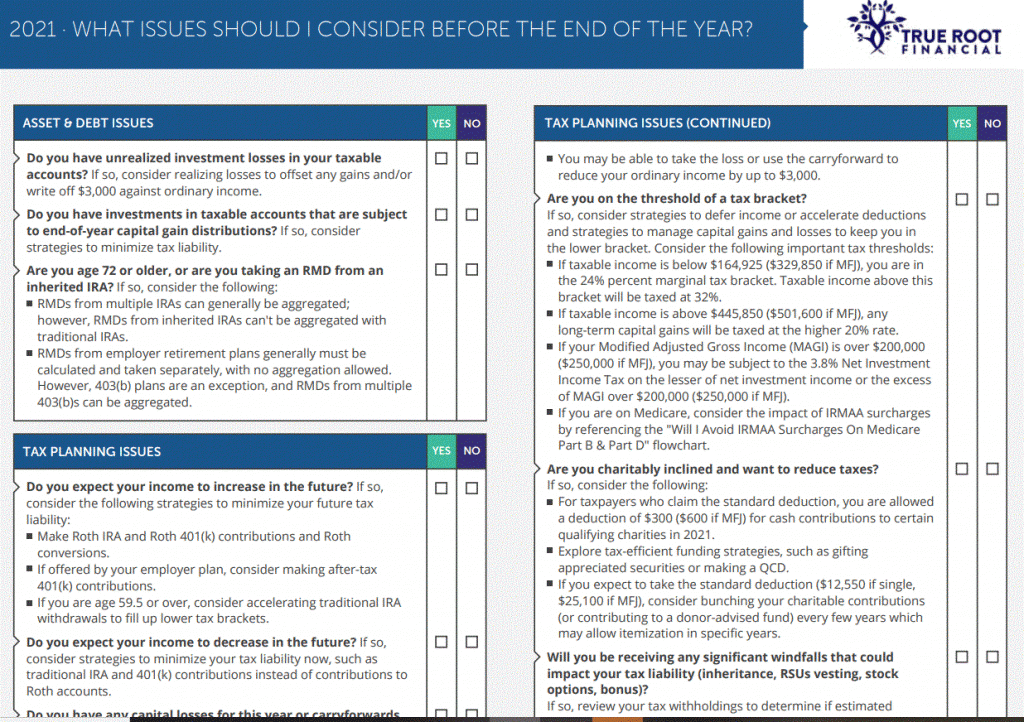Comprehensive financial planning guide for year-end
Roshani Pandey is a financial advisor and founder of True Root Financial. True Root Financial is located in San Francisco, CA and serves clients across the globe.
A comprehensive financial planning process addresses every aspect of your financial life – investing, cashflows, taxes, insurance and estate planning. While planning happens throughout the year, the year-end offers a unique vantage point to look back and make some decisions. As we approach the end of the year, here are some planning considerations that can really benefit your bottom line if executed properly.
Free Resource
Before you continue reading, grab this checklist of tax planning and financial planning activities to accomplish by year-end.
What issues should I consider before the end of the year?
4 main areas of comprehensive financial planning services to consider:
1. Investment management issues
Do you have unrealized investment losses?
If you have paper losses in your portfolio, consider turning them into actual losses. This process is called tax-loss harvesting, whereby you sell stocks that are currently under-water. Then 31 days later, after the Wash Sale period is over, you buy back the stock. This creates a tax loss for you that you can offset against other gains in your portfolio to reduce your capital gains taxes.
Both short-term and long-term losses can be valuable. If you don’t have enough capital gains to offset, you can also use up to $3,000 of the losses to reduce any income. For more information on tax-loss harvesting, read our article here.
Beware of mutual fund year-end distributions in taxable accounts
Many mutual funds distribute your share of capital gains and other taxes towards year-end. These distributions can be large for active mutual funds where the fund managers buy and sell often. In a year like 2021 where the markets have had a strong performance, you are likely to see big capital gains distributions.
Try to get an estimate of these distributions as early as possible and consider strategies to minimize tax liability. Read our article for 9 ways to avoid capital gains on stocks here.
2. Cash flow issues
Are you able to save more?
Your statement of cashflows compiles every income and expense and projects it out for the next several years to reflect your financial situation. Reviewing cashflows is one of the first steps we take in comprehensive financial planning. It allows you to evaluate your financial goals and make decisions on where the next dollar of your earnings should go – to a 401K, to an IRA, to a ROTH or to a 529 plan. This is where a financial advisor or a financial planner who you meet with periodically throughout the year can help you.
They can also do a tax analysis to point out when there are opportunities for a ROTH conversion. A Roth conversion is a process by which you can convert your tax-deferred accounts like a 401K or a traditional IRA into an after-tax account like ROTH and grow it tax-free.
To make a ROTH conversion successful, you have to do it in a year where your income is lower so that your tax bill is also lower as a result. To find ways to reduce your taxable income, read our article here.
Here are some great savings vehicles and their 2022 limits:
If you have an employer-sponsored 401K plan, the maximum you can contribute to it is $20,500, plus a catch-up contribution of $6,500 if you are over the age of 50.
Self-employed individuals or small business owners can contribute to a solo 401K or a SEP IRA. Note that your contributions for yourself to all of these plans combined cannot exceed 25% of your net earnings and can only be up to $61,000.
If you have an HSA account, consider contributing to it. HSAs are triple tax-exempt and highly advantageous.
Do you want to contribute to a 529 plan?
You can contribute up to $15,000 per year to each child without having to file additional paperwork for a gift tax return. This means that a couple can contribute up to $30,000 to each child without having to file gift tax returns. You can also “super-fund” the 529 plan by contributing up to $75,000 and treating it as if the gift were made evenly over a 5-year period. This way, the 529 plan grows faster as the investment starts compounding earlier.
Having said that, consider your cashflows and other goals such as your retirement as well as your lifestyle needs before superfunding the 529 plan.
3. Insurance planning issues
Flexible Spending Account (FSA)
FSA accounts let you set aside a certain amount of money to pay for medical expenses. In general, you are required to use your FSA funds by year-end or lose it.
If you have unused funds in your FSA, find out from your employer if you have any leeway.
Did you meet your annual health deductible?
If so, consider incurring any additional medical expenses before the end of the year. If possible, you could also re-schedule any annual exams you may do like mammograms, ultrasounds, etc. and do it before year-end.
4. Estate planning issues
No wealth management plan is complete without an estate plan. If your heirs have changed or if you have bought or sold assets, review your estate plan to make sure it still reflects your wishes.
Are there any gifts that still need to be made this year? If so, gifts up to the annual exclusion amount of $15,000 (per year, per donee) are gift tax-free.
If you would like to learn how our wealth management services and financial advice can benefit you, please book an introductory call below:










Leave a Reply
Want to join the discussion?Feel free to contribute!